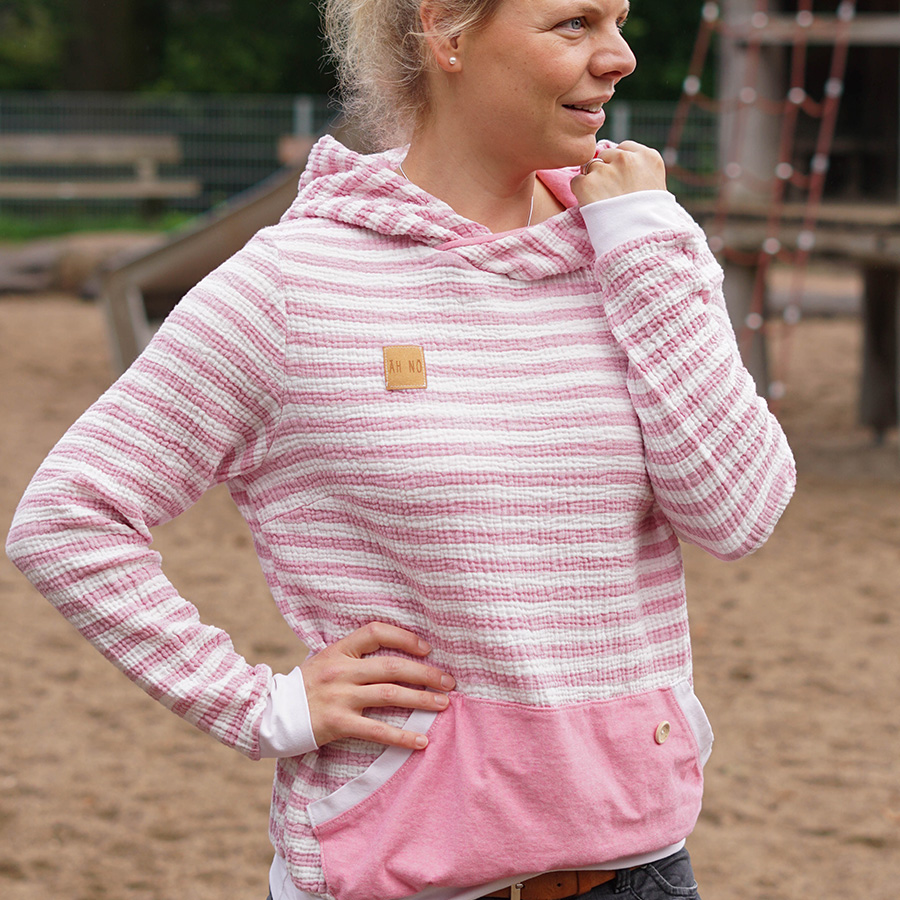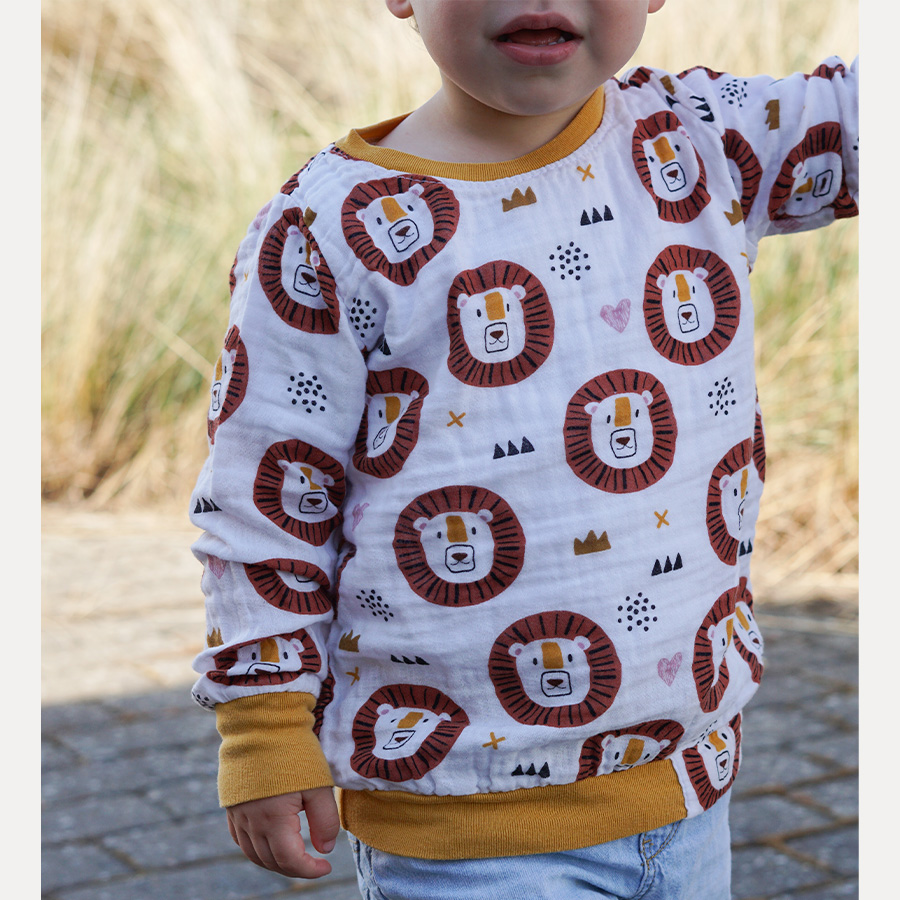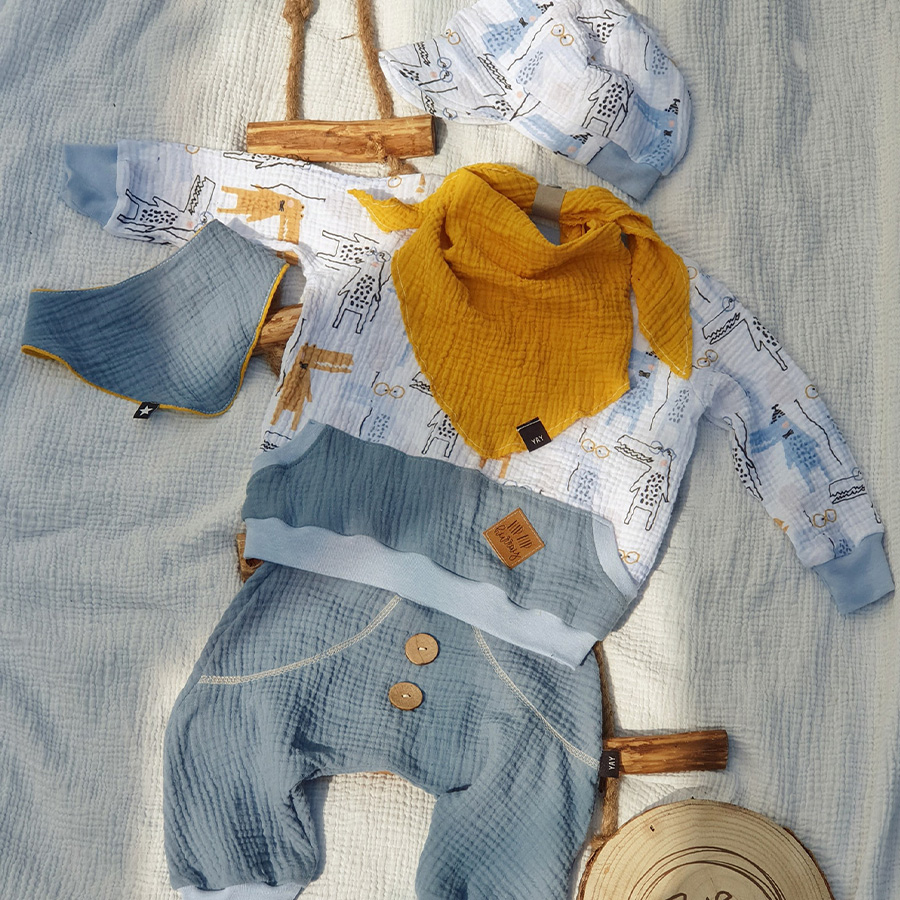Kennst du das Gefühl von Musselin auf der Haut? Ja?! Dann weißt du wie wunderbar es sich anfühlt. Ich liebe das luftige, leichte, zarte Gefühl von Musselin. Es ist einfach unglaublich angenehm zu tragen. Besonders für den Frühling, den Sommer und die Übergangszeit eignet sich der Stoff hervorragend. Musselin ist so viel mehr als ein Stoff für Babys und Spucktücher. Warum und was du beim Verarbeiten von Musselin beachten solltest, erfährst du jetzt.
As I really like muslin, you will find some patterns at Snyggli that are specially designed for muslin. The official muslin series from Snyggli has begun with the Musling hoodie / sweater. A loose hoodie that can also be worn next to the skin without a shirt underneath.

You can sew the Musling as a hoodie or as a sweater. In the sweater version, it almost looks a bit like a longsleeve. Here, the Hyggehue hat has been combined with the Musling.

For babies, there is the Musling baby sweater with an integrated button placket on the shoulder. If you want to sew a complete muslin outfit for your little darling, the Musling baby set is just the thing. You can also sew your little one the Luften bloomers, the Sommerluften and the Hyggehue hat to match the baby sweater. Two different scarves are also included.

I can’t tell you how much I love the feel of muslin against my skin. The hoodie feels so loose and light. A hint of nothing…

As the men were a little envious of their children’s and wives’ Muslings and would also like to experience the feeling of wearing muslin, the Musling hoodie/sweater is now also available for men.
Here you will find all the Snyggli patterns that are specially designed for muslin or can be sewn from muslin without any adjustments:
Hoodie/Sweater Musling Gr. 86-170
Baby sweater Musling size 56-104
Hoodie/Sweater Musling Ladies Gr. 32-50
Hoodie/Sweater Musling Men’s Gr. 40-60
Summer hat
Bloomers Luften Gr. 44-122 and Gr. 128-170
Bloomers Sommerluften Gr. 50-122
Baby set Musling (5 patterns) size 50-80
So far, you can only find tips & tricks for processing muslin in my muslin eBooks. With this blog post, I would now like to share the tips & tricks with you.
Properties of muslin
Muslin is usually made of cotton and is not stretchy. In the production of muslin, the threads are twisted slightly. This gives it its crinkly look. Muslin is light, flowing, soft and particularly absorbent. You can now also find printed muslin. This is often not quite as crinkly as plain muslin.

This muslin here, for example, is much thinner and less crinkly than “normal” plain muslin.
Washing: yes or no?
YES! Muslin shrinks considerably when washed. It is therefore essential to wash the fabric before sewing. Muslin only takes on its typical crinkled look after washing. Some muslin fabrics shrink considerably more than other types of fabric when washed. This can (but does not have to) be the case for up to 25%-30%. Please take this into account when deciding how much to buy.
Dryer: yes or no?
YES! After washing, put it in the dryer once and the crinkly muslin texture is immediately back. The fabric may shrink a little further in the dryer. Since I put (almost) everything in the dryer, shrinkage should be “finished” before sewing.
Ironing: yes or no?
NO: Never iron muslin before sewing. Ironing would make the muslin smooth again and therefore larger. If you were to sew an ironed muslin according to a size that actually fits, the garment will only fit if you iron it again each time before wearing it. However, it is sometimes necessary to iron the edges of pockets or hems, for example. It is really only important to iron the edge with the tip of the iron. I prefer to do this with the small mini iron*.
Wearing comfort
Muslin is a woven fabric that is not stretchy. It is therefore important that a pattern is specially designed for muslin/woven fabrics. If you were to use a narrow jersey cut, the garment would not fit or would tear immediately. Due to the crinkling, I find muslin more comfortable to wear than linen, for example. The crinkly effect “feels” slightly stretchy.
Stitch type, stitch length and needle
I recommend a stitch length of approx. 3 to 3.5. The stitch should not be too small. It is important that you do not pull the fabric when sewing.
We recommend using a thinner universal needle, e.g. size 70*. For somewhat coarser, thicker muslin fabrics, a size 80* or 90 universal needle* can also be used.
Serging: yes or no?
Most muslin edges hardly fray at all. However, this also varies slightly from muslin to muslin. If you don’t want fringes, you should neaten them.
Important information when sewing with the overlocker
You can also sew muslin together wonderfully with an overlocker. Or use the overlocker for serging. Important: if you are sewing together with the overlock, you should then sew with a straight stitch approx. 1 mm next to the overlock seam. This prevents the seams from tearing out.
Right and left fabric side
Most muslin fabrics do not have a recognizable right and left side. This is different with printed muslin. Here you can see a right and left side of the fabric.
Thread run
The grain of muslin is also parallel to the selvedge.
Now you have a wealth of knowledge about sewing muslin. I wish you lots of fun sewing my muslin patterns and experiencing the great feeling of wearing them.
All the love
Navina
*Affiliate links
